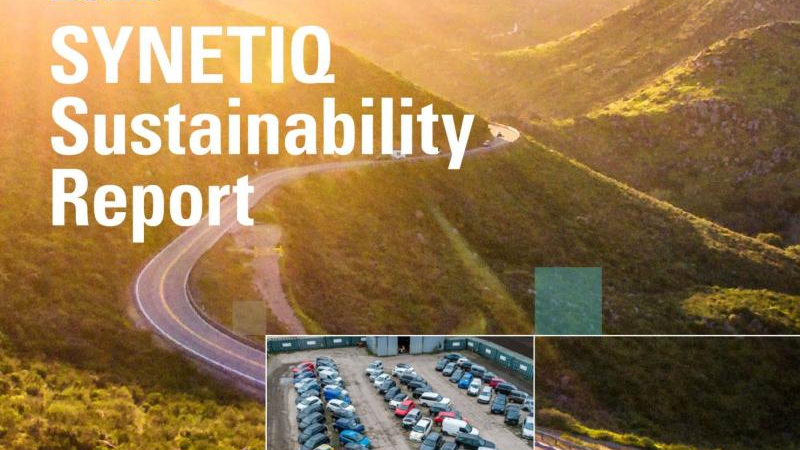SYNETIQ, an IAA company, and one of the UK’s largest integrated salvage, dismantling and vehicle recycling companies, announces the publication of its first sustainability report, which highlights its progress against the company’s carbon reduction strategy and demonstrates how SYNETIQ creates value for its stakeholders and customers.
The business is pleased to report a 5.6% reduction in its own greenhouse gas (GHG) emissions between 2020-21 and 2021-22. Future reports will account for integration with IAA in the UK as the businesses operate as a single entity, and the report includes its new baseline emissions data for both the legacy businesses.
“I’m pleased to present SYNETIQ’s first sustainability report, which explains how our business enables us to create value for our clients and other stakeholders whilst contributing to a more sustainable society,” said SYNETIQ Sustainability Manager Elisa Caton. “We want to make a verifiable contribution to the sustainable development of our industry and community. To this end, we are proud to make our actions transparent and traceable through comprehensive reporting, and as such our first report also provides an overview of how we intend to meet our targets in the short, medium- and long-term.”
Steady progress towards sustainability goals
The new report shows that the measures taken in recent years are having an impact. In addition, the business helped its clients reduce or avoid GHG emissions, saving them 4.34 million KG of CO2e through its supply of green parts in 2022.
The business achieved Silver Carbon Literacy status in 2021 and is well on its way to becoming Gold accredited, for which 50% of its workforce must have passed SYNETIQ’s own climate and sustainability training.
Since the launch of its sustainability strategy Our Road to Tomorrow in April 2021, SYNETIQ has made continuous progress towards its three main goals of fostering a carbon-conscious culture within the business and supply chain, putting in place projects to help reduce emissions to net zero, and continuously improving data relating to the emissions savings from using green parts. The report also details SYNETIQ’s future plans for sustainability within seven specific workstreams across its operations: transport, estate, energy, circularity and waste, culture, offsetting and compliance.
UK Managing Director for IAA and CEO of SYNETIQ Tom Rumboll said: “As a business, we understand that climate change is a serious threat, not just to the communities around us but to businesses worldwide too. We also recognise the opportunities that robust sustainability strategies can bring. Our sustainability report puts us one step further along our journey to lead the industry and demonstrate our commitment to do the right thing by our colleagues, customers and business.”
Find more information in the SYNETIQ Sustainability Report 2022 at https://bit.ly/3L0aRX5.
Forward-Looking Statements
IAA Holdings, LLC (as successor to IAA, Inc.) (“IAA”), a leading global digital marketplace connecting vehicle buyers and sellers, is now a subsidiary of Ritchie Bros. Auctioneers Incorporated. This release includes forward-looking information within the meaning of Canadian securities legislation and forward-looking statements within the meaning of Section 27A of the Securities Act of 1933, as amended, Section 21E of the Securities Exchange Act of 1934, as amended, and the Private Securities Litigation Reform Act of 1995 (collectively, “forward-looking statements”). Forward-looking statements may include statements relating to future events and anticipated results of operations, business strategies, the expected timing and associated benefits with respect to the announcement of the publication of the SYNETIQ sustainability report and other subjects of this release on our business and plans regarding our growth strategies, and to our customers and company generally, and other aspects of RBA’s or IAA’s respective businesses, operations, financial condition or operating results and other statements that are not historical facts. Words such as “should,” “may,” “will,” “anticipates,” “expects,” “intends,” “plans,” “believes,” “seeks,” “estimates” “could,” “can,” “intends,” “target,” “goal,” “projects,” “contemplates,” “believes,” “predicts,” “potential,” “continue,” “foresees,” “forecasts,” “estimates,” “opportunity” and similar expressions identify forward- looking statements. It is uncertain whether any of the events anticipated by the forward-looking statements will transpire or occur, or if any of them do, what impact they will have on the results of operations and financial condition of the combined companies or the price of RBA’s common shares. Therefore, you should not place undue reliance on any such statements and caution must be exercised in relying on forward-looking statements. While RBA’s management believe the assumptions underlying the forward-looking statements are reasonable, these forward-looking statements involve certain risks and uncertainties, many of which are beyond RBA’s control, that could cause actual results to differ materially from those indicated in such forward-looking statements, including but not limited to: the effects of the business combination of RBA and IAA, including the combined company’s future financial condition, results of operations, strategy and plans; potential adverse reactions or changes to business or employee relationships, including those resulting from the completion of the merger; the diversion of management time on transaction-related issues; the response of competitors to the merger; the ultimate difficulty, timing, cost and results of integrating the operations of RBA and IAA; the fact that operating costs and business disruption may be greater than expected following the consummation of the merger; the effect of the consummation of the merger on the trading price of RBA’s common shares; the ability of RBA to retain and hire key personnel and employees; the significant costs associated with the merger; the outcome of any legal proceedings that could be instituted against RBA; the ability of the combined company to realize anticipated synergies in the amount, manner or timeframe expected or at all; the failure of the combined company to realize potential revenue, EBITDA, growth, operational enhancement, expansion or other value creation opportunities from the sources or in the amount, manner or timeframe expected or at all; the failure of the trading multiple of the combined company to normalize or re-rate and other fluctuations in such trading multiple; changes in capital markets and the ability of the combined company to generate cash flow and/or finance operations in the manner expected or to de-lever in the timeframe expected; the failure of RBA or the combined company to meet financial forecasts and/or KPI targets; legislative, regulatory and economic developments affecting the business of RBA; general economic and market developments and conditions; the evolving legal, regulatory and tax regimes under which RBA operates; unpredictability and severity of catastrophic events, including, but not limited to, pandemics, acts of terrorism or outbreak of war or hostilities, as well as RBA’s response to any of the aforementioned factors. Other risks that could cause actual results to differ materially from those described in the forward-looking statements are included in RBA’s periodic reports and other filings with the Securities and Exchange Commission (“SEC”) and/or applicable Canadian securities regulatory authorities, including the risk factors identified under Item 1A “Risk Factors” and the section titled “Summary of Risk Factors” in RBA’s most recent Annual Report on Form 10-K for the fiscal year ended December 31, 2022, and IAA’s periodic reports and other filings with the SEC, including the risk factors identified under Item 1A “Risk Factors” and the section titled “Summary of Risks Affecting our Business” in IAA’s most recent Annual Report on Form 10-K for the fiscal year ended January 1, 2023. The forward-looking statements included in this release are made only as of the date hereof. While the list of factors presented here is considered representative, no such list should be considered to be a complete statement of all potential risks and uncertainties. Many of these risk factors are outside of our control, and as such, they involve risks which are not currently known that could cause actual results to differ materially from those discussed or implied herein. RBA does not undertake any obligation to update any forward-looking statements to reflect actual results, new information, future events, changes in its expectations or other circumstances that exist after the date as of which the forward-looking statements were made, except as required by law.





